5.3 Output devices
|
Previous
Chapter 4: File and print management
|
Next
Chapter 6: Extended hardware concepts
|
 CHAPTER OVERVIEW
CHAPTER OVERVIEW
| Unit 5.1 | What is hardware? |
| Unit 5.2 | Input devices |
| Unit 5.3 | Output devices |
| Unit 5.4 | Storage devices |
| Unit 5.5 | Green computing |
 At the end of this chapter, you should be able to:
At the end of this chapter, you should be able to:
- Define and describe what hardware is.
- List the various types of ports and connectors.
- Define input.
- Discuss the types of input.
- Discuss the common input devices used.
- Define output.
- Identify the different types of output.
- Discuss the common output devices used.
- Define storage.
- Identify the different storage devices used.
- Use different methods to connect peripherals.
- Understand the importance of green computing and recycling.
INTRODUCTION
Have you ever wondered what we would do without computers in this day and age? Pretty much everything in this world works with computers; from using an ATM, to buying groceries and making new friends. We live in a world where, after you have bought a new computer, taken it home and, before even unpacking it, there is an advertisement for a new computer that makes yours now outdated.
According to Moore’s law (1970), computer processor speeds will double every two years. For this to happen, a computer’s components must be improved on a continuous basis.
Looking back to where computers started, you will realise that it was not at all as complex or technologically advanced, such as the ones we have today. In the early 1600s to 1800s, people started thinking of building a device that could solve complex problems and calculations easier and faster than what they could do manually. They wanted a device that could add and subtract. As a result, the first digital calculator that could add and subtract was built by the 18-year-old Blaise Pascal in 1642.
As the years went by, newer and better calculators and computers were built. One of the first complex machines that forms an important part of the computer history, was the ENIAC, built for the US army between 1943 and 1946. It was a very big computer that could do thousands of calculations.
After that, computers started changing the world more and more as it became smaller, faster and smarter.
UNIT
5.1 What is hardware?

HARDWARE BASICS
Have a look at this video to see a 3D virtual tour of hardware:

A computer consists of two major parts – i.e. hardware and software.
Hardware refers to all the physical parts or components of a computer, such as the monitor, keyboard, computer data storage, graphics card, sound card and motherboard. Software refers to the instructions that can be stored and run by hardware.
There are many different kinds of hardware that can be installed inside, or connected to the outside of a computer. To make it easier for you to understand, we will divide it into the following categories:
- Input devices
- Output devices
- Storage devices
PORTS AND CONNECTORS
Ports and connectors form an important part of a computer. Ports allow computers to connect with different types of hardware, such as a keyboard, mouse or monitor. Many devices use cables to connect to the computer. Devices can also be connected using Wi-Fi (wireless), or Bluetooth (short-range wireless).
The connector (plug) which is found at the end of a cable fits into a specific port (socket) of the computer. These ports are usually found at the back of the computer.
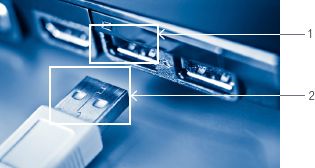
Table 5.1: Types of ports, common connectors and examples

ADAPTERS AND CONVERTORS
Almost every peripheral device uses an adapter to communicate with a computer. With new technology, the type of computer ports and other computing devices change. However, instead of buying a new computing device, you can use an adaptor convertor to provide additional compatibility and functionality.
Types of common adaptors include the following:
- HDMI to VGA
- HDMI to DVI
 Activity 5.1
Activity 5.1
1.Define the concept hardware.
2.Match the port in Column A with the correct device in Column B.

3.Briefly explain when adaptors are used.
UNIT
5.2 Input devices
Input devices are hardware devices that allow you to enter data into the computer, or interact with the computer.
Remember, when entering data, you are actually giving the computer an instruction to do something. In this section, you will learn about the different types of commonly used input devices.
COMMON INPUT DEVICES
KEYBOARD
A keyboard is used for entering information into a computer, such as letters, words, numbers and symbols. Pressing any key on the keyboard is an input that the computer uses as data. There are different types of keyboards, as shown in the table below.
Table 5.2: Different types of keyboards


Something to know
The concept of pressing a key to type text has been around for a very long time. One of the early inventions, which later became the typewriter, was invented by Pellegrino Turri for his blind girlfriend so that she could write letters to him.

Something to know
The Oxford Dictionary acknowledges both “computer mice” and “computer mouses” as the correct plural forms of the term. For the purpose of this book, however, we will be using the plural form “mice”.
POINTING DEVICES
Pointing devices are used to control the movement of the cursor on the screen. The major pointing device is the mouse for the desktop computer and the touchpad for the laptop.
MOUSE
The mouse is the second most important input device of a computer. Using the mouse, you can move the mouse pointer or cursor on the computer screen, allowing you to interact with the computer.
There are different types of mice, as shown in the following table.
Table 5.3: Different types of mice

FIRST COMPUTER MOUSE
Douglas Engelbart invented the first computer mouse in 1963. The mouse had two wheels positioned at a 90-degree angle to each other to keep track of the movement. The ball mouse was only invented in 1972 and the optical mouse, around 1980.
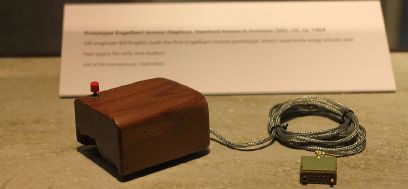
 Activity 5.2
Activity 5.2
1.Fill in the following crossword puzzle using the clues that are provided.
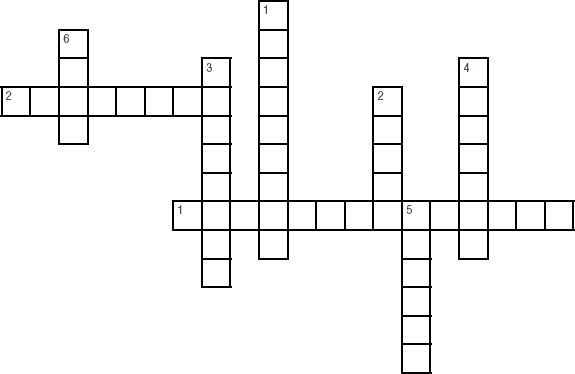
Across
1.A type of wireless technology mice used
2.Physical component of a computer like a mouse
Down
1.Which type of keyboard is used to minimise muscle strain
2.Used to move the pointer on a screen
3.For entering information, such as letters, words, numbers and symbols into the computer
4.Controls movement of the cursor
5.The standard keyboard
6.This allows computers to connect with different types of hardware, such as a keyboard, mouse or monitor
UNIT
5.3 Output devices
Output devices receive data from a computer. The output device converts this data to a display, projected image, or print-out.
COMMON OUTPUT DEVICES
MONITORS
A monitor, also known as a visual display unit (VDU), is the main output device of a computer, as it represents data in a visual form.

The size of a monitor is measured in inches diagonally from one corner to the other.

Something to know
An inch is about 2.5 cm; therefore, a 22-inch monitor has a diagonal length of 22 × 2.5 cm = 55 cm.

Something to know
The resolution of a monitor is measured in PPI (pixels per inch).
Another important aspect of a monitor is its resolution. The clarity of text and images displayed on the monitor depends on the screen resolution. Screen resolution is measured in pixels (which is short for picture element). A pixel is a tiny dot of colour displayed on a monitor. The more pixels there are, the more detailed the picture will look. The screen resolution shows you how many pixels the screen can show horizontally and vertically. It is written as 1 280 × 800, which means that the screen can show 1 280 pixels horizontally and 800 pixels vertically.
A third important characteristic is the refresh rate of a monitor. This can be defined as how quickly the image on the monitor can be updated with the newest information.
PRINTERS
Printers allow a computer to convert electronic data (soft copy) into a hard copy (i.e. printed out on a piece of paper). Printers are generally used to print large amounts of text and documents, and can also be used to print graphics, such as photos.
For the purpose of this book, we will only look at the following four printers:
1.Inkjet printer: This is a very popular printer that can combine black, white and colour printing, all at the same time. These printers operate by using cartridges that contain the ink. When the print job starts, the ink heats up and flows through a set of tiny holes. The heating process results in a small droplet of ink forming, which is then released as a single dot, forming a part of the image or text. This happens continuously until the whole image or text has been completed. This is why inkjet print-outs are sometimes still a bit wet. This type of printer can be seen in Figure 5.4 and are commonly used in homes.
2.Ink tank printer: An ink tank printer uses the same technology as an inkjet printer to print documents. The difference is that an inkjet printer’s ink cartridges are replaced with ink tanks, which hold a much larger volume of ink (up to 70 ml). The ink tanks can be filled by the user when they are empty. Each colour is stored in a separate tank and only the colour that is used up, has to be refilled. Ink tank printers can print 1 000 pages or more. Ink tank printers are suitable for printing documents where a large number of copies are required.
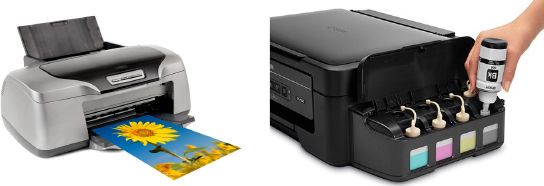

INKJET PRINTER VERSUS LASER PRINTER
3.Laser printer: This is a common printer used in the workplace. It can print a lot of sheets quickly and with high quality. A laser printer works by directing a laser beam onto a drum, which forms a mirror image of what has to be printed. This causes parts of the drum to be magnetised. When the drum rotates, it picks up the ink powder, called toner. The toner is then transferred to the paper, printing the letters or images on it with a hot roller bonding the toner to the paper. An example of this printer can be seen in Figure 5.5.
4.3D printer: 3D printing is the process of making a three-dimensional (3D) solid model from a digital file. It works by transforming a digital file into a 3D model by adding one layer of material at a time.


Print resolution is measured in dots per inch (DPI). This is similar to the way pixels work on a computer. The printer settings can be adjusted to increase or decrease the DPI. The higher the DPI, the more dots there are, resulting in a high-quality print-out.
The following table shows the comparison between various kinds of printers.
Table 5.4: Advantages and disadvantages of different printers

 Activity 5.3
Activity 5.3
Lesedi’s dad got an inkjet printer for the house; however, it is not working and no printing is taking place. It seems that there is no communication between the printer and the computer.
Answer the following questions regarding the scenario:
1.Which connector do printers usually have?
2.Briefly explain why a printer is an output device.
3.List two advantages and two disadvantages of the printer that Lesedi’s dad bought.
4.Explain one possible reason why the printer and computer are not communicating.
UNIT
5.4 Storage devices

Something to know
There is a difference between storage media and a storage device. Storage media is anything that holds information. It refers to the digital medium that is used in the storage devices, for example magnetic disks, cards, barcodes, etc. A storage device is a device that uses the storage medium and provides a physical interface, such as a CD/DVD player, an external hard drive, a USB flash drive, etc.
Storage devices are used to store data. There are a variety of storage devices with differences in storage capacity, speed, portability, as well as functions. In this section, you will learn about the different types of storage devices and how they are used – i.e. how much data needs to be stored, how quickly the data needs to be transferred and how portable the storage needs to be.
CONCEPTS USED IN STORAGE CAPACITY
Before we discuss storage devices in great detail, let’s quickly look at the different capacities storage devices can have.
Data on computers is stored as numbers, which consist of only 0s and 1s. Computer memory is made up of electronic components, which can either be on (1), or off (0). The smallest unit of data storage (0 or 1) is called a bit. A number made up of eight bits (11111111) is called a byte.
Table 5.5: Measuring capacity
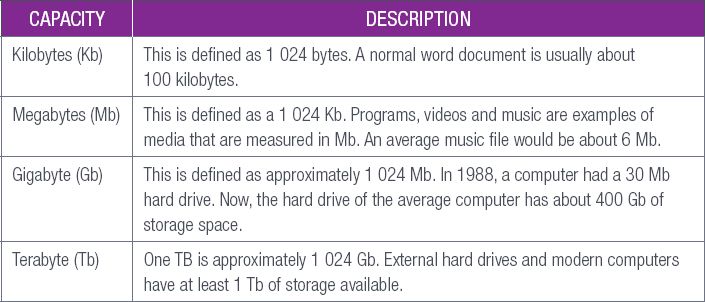
COMMON STORAGE DEVICES
Nowadays, we are used to hundreds of gigabytes of storage capacity in our computers. With looking at storage devices, there are three main things to remember:
1.Storage capacity: This determines how much data can be stored on the device.
2.Storage speed: This determines how quickly new information can be written to the device.
3.Reliability: This determines the likelihood of the device breaking down.
We will look at the following storage devices:
1.Internal hard drive (fixed)
2.External hard drive (portable)
3.SD card
4.Solid-state drive (SSD)
5.Flash drive
Table 5.6: Types of common storage devices
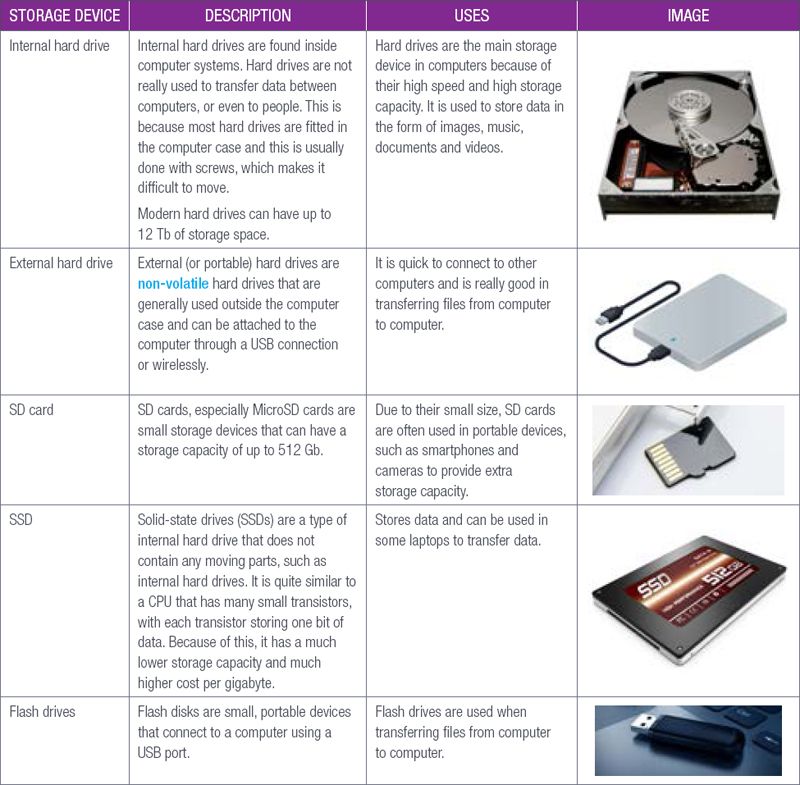
LIFE SPAN OF A HARD DRIVE
Hard drives contain sensitive moving parts and because of this, they can fail. Data stored on hard drives should always be backed up (stored on another device). Modern hard drives can last for more than ten years.
The following signs show that the hard drive might be failing:
- The computer is slowing down
- There is a clicking or grinding sound
- The computer freezes frequently

Something to know
In January 2018, SanDisk (a flash disk manufacturer) unveiled the world’s smallest one Tb flash disk at the consumer electronics show in Las Vegas. Although this is still only a prototype, it may eventually completely eliminate the need for external hard drives.
CAPACITY AND ROBUSTNESS OF STORAGE DEVICES
The following table summarises the average capacity and robustness for different types of storage devices, provided that they are used correctly.
Table 5.7: The average capacity and robustness of storage devices
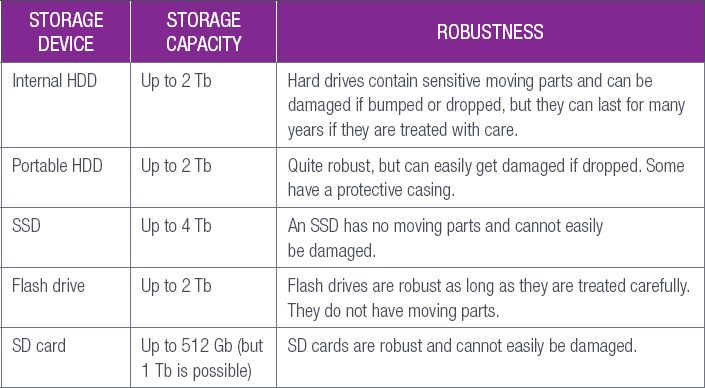
CONNECTING PERIPHERALS
A peripheral is an external device that is connected to a computer. A PC on its own cannot function efficiently. It needs peripherals, such as a mouse or keyboard for the PC to operate properly.
Peripherals can be both cabled (wired) or wireless, and uses USB, Bluetooth or Wi-Fi. In this section, we will look at the different methods of connecting peripherals.
 Guided Activity 5.1
Guided Activity 5.1
CABLED CONNECTIONS (USB)
To connect a keyboard with a USB cable, you can do the following:
1.Plug the USB cable of the peripheral device into the computer’s USB port.
2.The computer will register the keyboard. You can then start using the keyboard immediately.
WIRELESS CONNECTIONS (BLUETOOTH)
To connect a new peripheral using Bluetooth, you can do the following:
1.Open Settings.
2.The Settings window will open.
3.Click on Devices.
4.From the left panel, click on the Bluetooth & other devices tab.
5.Turn the Bluetooth toggle switch on.
6.Click on the Add Bluetooth or other device button.

Take note
Install any drivers if prompted.
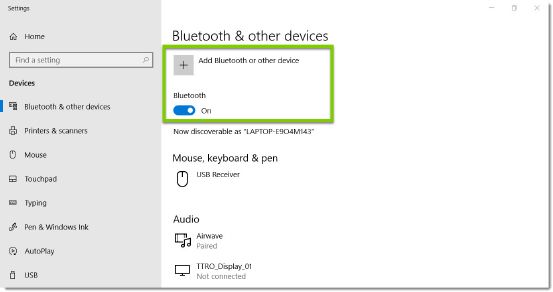
7.Select the Bluetooth option.
8.Switch on the peripheral device.
9.A list of peripheral devices will appear. Choose the device and click it to connect.
10.Click on the connect button to pair.
11.Click Done.
WI-FI
To connect a new peripheral using Wi-Fi, you can do the following:
1.Click on Start > Devices and Printers > Add a printer.
2.The Add a printer window will open.
3.Choose the Add a network, wireless or Bluetooth printer and follow the instructions.
 Activity 5.4
Activity 5.4
1.What is the smallest unit of storage capacity?
2.Which one of the following options describes the type of devices used to keep an electronic record of work done on a computer?
A.Input
B.Output
C.Processing
D.Storage
3.Fill in the missing word: There are 1 024 kilobytes in a __________.
4.Generally speaking, a hard drive has an average life span of three to five years, depending on the brand, size and type of environment.
a.Do you agree with the statement? Motivate your answer.
b.List two ways that indicate a hard disk is starting to fail.
c.Briefly explain why an internal hard disk is more prone to damage compared to a portable hard disk.
UNIT
5.5 Green computing
Green computing is about using computers in an environmentally responsible and eco-friendly manner. Green computing aims to reduce the use and impact of hazardous materials, maximise energy efficiency and promote recycling of computers that are no longer being used.
Green computing tries to reduce the environmental effect of computers, by making computers more efficient and making sure the computers are built from biodegradable materials.
Some examples of green computing include:
- Computers going to “sleep” after they have been inactive for a certain amount of time.
- Data stored on SSDs use considerably less electricity than data on disk drives.
- Improved CPU architecture allows less electricity to create more power.
- More efficient software requires less processing and storage space, which requires less electricity.
- Better resource allocation means unnecessary computers in data centres can be turned off, saving a lot of electricity.
These improvements have already made significant improvements to the energy use of computers.
GOING GREEN WHEN PRINTING
With printing, you need to understand the negative effect that printing has on the environment. Currently, too much paper is been wasted for printing; most printed copies are generally ignored or thrown away after they have been used once. We should print documents when necessary, and rather file and send documents electronically (for example, through email). You can also save paper by printing on both sides of the paper (double-sided printing), as well as by recycling paper.
Disposing printer cartridges in the wrong way (throwing them out in the environment) can cause serious damage to the environment. Rather, find a disposal outlet that has special bins for this purpose, for example, this type of outlet can be found at a local supermarket, such as PicknPay.

 Activity 5.5
Activity 5.5
1.Explain the aim of green computing.
2.Describe three ways in which green computing can be achieved. Use ONLY examples related to hardware and software.
REVISION ACTIVITY
1.Match the ports in Column A to the connectors in Column B.
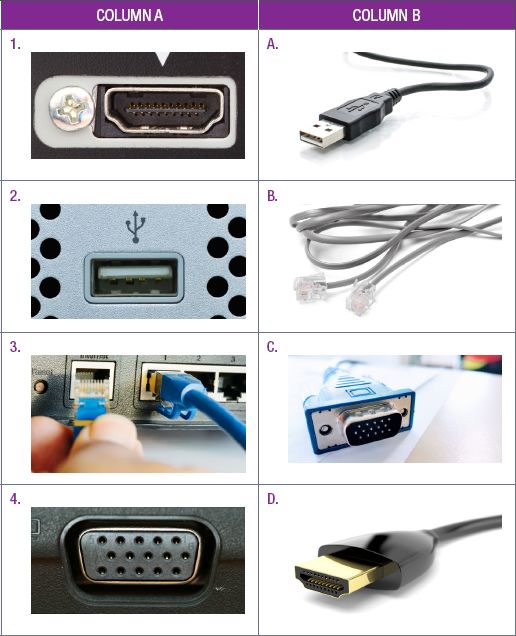
(4)
2.Write down the missing numbers:
a.1 Mb = ______ Kb (1)
b.1 Tb = ______ Mb (1)
3.In some laptops, internal hard disk drives are being replaced by SSDs.
a.What do the letters SSD stand for? (1)
b.Mention one advantage of using an SSD. (1)
c.Mention one disadvantage of using an SSD. (1)
4.Mr Chotia has a small work-from-home business. He has a computer that he uses to do basic accounting and keeps a record of appointments with clients. He also needs to print out quotations and receipts.
a.Mr Chotia has purchased a desktop computer. Other than a printer, list three hardware devices that are essential for Mr Chotia to be able to use the computer. (3)
b.Which of the devices mentioned in (a) above can be used as both an input and as an output device? (1)
c.Mr Chotia has been advised to purchase a laser printer. Comment on this advice. (2)
d.Mr Chotia loads a file with a customer receipt into a word processor. He then prints out the receipt. Which of the above (file or print-out) would be referred to as a hard copy? (1)
e.Mention two ways in which Mr Chotia could connect the printer to the computer. Which method would you recommend? (4)
f.Mr Chotia is an environmentally aware member of the community. Mention two ways in which he can save paper in his business. (2)
TOTAL: [22]
AT THE END OF THE CHAPTER
Use the checklist to make sure that you worked through the following and that you understand it.

|
Previous
Chapter 4: File and print management
|
Table of Contents |
Next
Chapter 6: Extended hardware concepts
|


